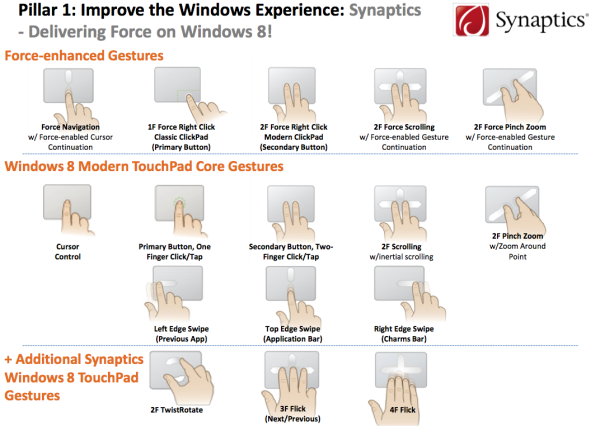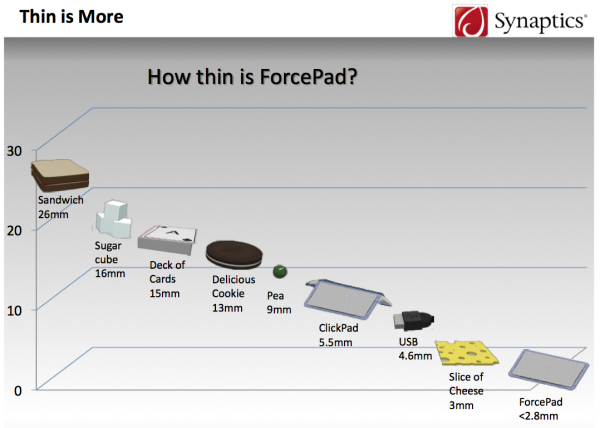Synaptics ForcePad: A Thinner, Pressure Sensitive Trackpad for Notebooks
by Anand Lal Shimpi on August 20, 2012 9:00 AM ESTLate last week I talked a bit about Synaptics’ smartphone touch technology, but today’s announcements apply to their role in the notebook space. Today Synaptics is announcing two new technologies: a pressure sensitive trackpad, and an ultrathin capacitive touch keyboard with mechanical keys. Both technologies are aimed at making notebooks even thinner, which helps explain their introduction prior to the arrival of Haswell Ultrabooks.
As a recap, Synaptics and its competitors provide touch controllers to OEMs for use in their notebook trackpads. Its the combination of hardware, firmware and software that can make or break the experience.
Currently most Ultrabooks use a top-hinged clickpad, where the entire tracking surface acts as a physical button. Since the clickpad has a hinge at the top, you have to apply more pressure if you try to click near the top of the pad otherwise it’s pretty comfortable. The benefit of making the whole pad a button is that you can do away with traditional buttons, giving you one large, contiguous tracking surface - perfect for gestures.
The downside to any mechanical clickpad is the additional thickness required by the hinge. As the line between notebook and tablet continues to blur, all components have to slim down. Hard drives, for example, went from 9.5mm to 7mm and are now being replaced by SSDs either on a daughtercard or on the motherboard itself. In pursuit of doing the same thing to trackpads, Synaptics is introducing the ForcePad.
The Synaptics ForcePad is a non-mechanical, pressure sensitive, capacitive trackpad. There are no physical buttons, like a traditional clickpad, allowing for a large tracking surface. Unlike a clickpad however, the ForcePad has no hinge - it doesn’t move at all.
The ForcePad can detect pressure, so it can tell when you’re trying to click vs. track. Simply mouse around like you would with a normal clickpad, then apply pressure with your finger as if you were going to click. The sensor can detect 64 discrete pressure levels at 15 gram intervals for up to five fingers concurrently. Synaptics’ driver will even play an audible click noise through your notebook’s speakers when you press down on the ForcePad, although most folks apparently opt to turn this off after about an hour.
In practice clicking on the ForcePad works a bit like an uncomfortable clickpad - the lack of any give in the tracking surface itself makes me want to just tap to click instead but it does work. Synaptics tells me that most users just get used to the lack of a physical click over time. Those who just use tap to click anyway won’t notice a difference at all. It’s really the old school folks (yours truly included) who still appreciate a good click that may have trouble adjusting.
If you can make the adjustment however, there are some inherent advantages to the ForcePad. Dragging using the ForcePad is really nice. Just press and hold on an icon like you would with a clickpad, but then release some of the pressure and just lightly drag the icon around. Since you’re not physically actuating a switch, the initially heavy pressure is only needed to communicate that you want to click - it’s not necessary to maintain that level of pressure going forward.
Pressure sensitive gestures are also a benefit of the ForcePad. Synaptics baked a few into its Windows 8 driver, for example you can easily scroll down a page when you get to the bottom edge of the ForcePad just by applying directional pressure. The same applies to standard two finger scrolling.
Most of the benefits of having a pressure sensitive trackpad really come with proper software support, which of course demands broad adoption of the ForcePad - something that simply isn’t guaranteed and not present initially. As an example of what could be, Synaptics showed a demo of a flight simulator where you could control movement along a plane’s roll axis by applying pressure to one of two fingers on the ForcePad. The harder you press, the quicker the plane rotates.
The big win with the ForcePad however is its reduction in thickness. By doing away with any mechanical motion, Synaptics claims up to a 40% thinner design than a standard Synaptics ClickPad. Any savings in z-height can help when it comes to shrinking overall chassis thickness, increasing battery capacity or both.

















7 Comments
View All Comments
ViRGE - Monday, August 20, 2012 - link
Eh, I don't know. The Apple-style clickpad made a great deal of since once touchpad quality reached a point where multi-touch was reliable, especially since Mac OS X was designed around a single mouse button in the first place.But this? It's the evolution of the tappad. Those have always been finicky experiences, and I'm not sure it's the technology to blame there. This strikes me as a scenario where having a button is going to remain superior. Having that level of feedback is very important, not to mention the fact that a pure touch surface opens up some interface ambiguities that don't currently exist with clickpads. Anyone that has had to deal with a tablet confusing taping and dragging knows what I'm talking about.
Wizzdo - Monday, August 20, 2012 - link
This excites me more than the keyboard announcement. Some really nice applications for music and drawing as well (with driver support dang it!).gostan - Monday, August 20, 2012 - link
copying apple eh?Pirks - Monday, August 20, 2012 - link
...we Windows users will be just sitting aside salivating over MacBooks 'cause Apple will always integrate cool stuff faster and better than others due to tight vertical integration of OS and hardware.MS needs to up the game, Surface is NOT enough. They have to start making their own ultrabook next, full of advanced Win8 stuff like those glass touchpads with multitouch gesture support, retina screens, etc.
MS will fall into oblivion eventually if they won't up the game on hardware front. Crappy cheapshit producing OEMs are NOT enough these days, Apple is pwning MS financially very hard and it hurts to see how MS is slowly sliding into irrelevance.
I hope Ballmer is not a TOTAL IDIOT and that he will start making his own phones and ultrabooks eventually. Non-integrated cheapo bloatware ridden OEM crap IS NOT ENOUGH to compete with Apple.
I've been creaming that to local idiots like motoman and cheesy clown for a VERY LONG time already, glad to see Ballmer is following my line of thought and doesn't listen to his own MS oldfags that troll Apple motoman/cheesy clown-style. But he's not moving in that direction fast enough, we need more highly integrated premium quality MS PC hardware RIGHT NOW!
Apple will keep pwning idiot cheesy clown trolls and motomans with their insane profits that make MS look like an ugly midget financially, until Ballmer wakes up. Or until someone faster and smarter than him appears as MS CEO.
Hurray to MS hardware like Surface! THE NEXT STEP CAN'T COME FAST ENOUGH! Hear that Ballmer? The world is watching ya fat bastard :)))
funnyhog - Saturday, March 21, 2015 - link
salivating? Over the overpriced and underspecced hardware of iFruity? hardly.And btw, iFruity simply uses many of others tech, while they are good optimiser, they are hardly innovative at all.
And given how MS is a software company first and foremost, making hardware is hardly their priorities. But what will be good will be getting quality partners who can produce outstanding laptops that utilised the strength of their OS.
PS ... iFruity does not in fact uses high quality hard ware, going by their bill of materials. And moreover, remember that Aluminium is in fact one of the cheaper, weaker and softer metal available.
iamkyle - Saturday, August 25, 2012 - link
My only gripe with this is that over time, being made of a plastic material, it will lose its pressure sensitivity either causing a pressure level to be registered when none is there, or will require re-calibration.funnyhog - Saturday, March 21, 2015 - link
.... being made of plastic composites does not mean that it will lose its pressure sensitivity. Where on earth did you get that idea from?